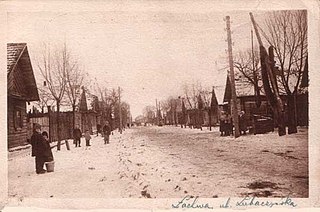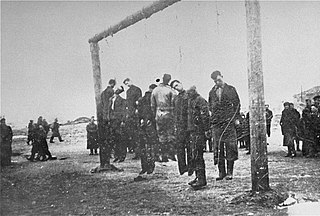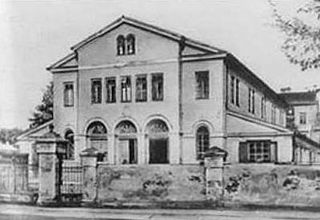Related Research Articles

The Final Solution or the Final Solution to the Jewish Question was a Nazi plan for the genocide of Jews during World War II. The "Final Solution to the Jewish question" was the official code name for the murder of all Jews within reach, which was not restricted to the European continent. This policy of deliberate and systematic genocide starting across German-occupied Europe was formulated in procedural and geopolitical terms by Nazi leadership in January 1942 at the Wannsee Conference held near Berlin, and culminated in the Holocaust, which saw the murder of 90% of Polish Jews, and two-thirds of the Jewish population of Europe.

Olyka is an urban-type settlement in Kivertsi Raion, Volyn Oblast, Ukraine. It is located east of Lutsk on the Putilovka Rriver. Its population is 3,060 .

Sarny, translated as Does, is a small city in Rivne Oblast (province) of western Ukraine. It is the administrative center of Sarny Raion (district), and is a major railway node on the Sluch River. Population: 28,865

Lakhva is a small town in southern Belarus, with a population of approximately 2,100. Lakhva is considered to have been the location of one of the first, if not the first, Jewish ghetto uprisings of the Second World War.

The Lwów Ghetto was a Nazi ghetto in the city of Lwów in the territory of Nazi-administered General Government in German-occupied Poland.

The Holocaust in Poland was part of the European-wide Holocaust organized by Nazi Germany and took place in German-occupied Poland. During the genocide, three million Polish Jews were murdered, half of all Jews murdered during the Holocaust.

Janowska concentration camp was a German Nazi concentration camp combining elements of labor, transit, and extermination camps. It was established in September 1941 on the outskirts of Lwów in what had become, after the German invasion, the General Government. The camp was named after the nearby street Janowska in Lwów of the interwar Second Polish Republic.

The Minsk Ghetto was created soon after the German invasion of the Soviet Union. It was one of the largest in Belorussian SSR, and the largest in the German-occupied territory of the Soviet Union. It housed close to 100,000 Jews, most of whom were murdered in The Holocaust.

ŁachwaGhetto was a Nazi ghetto in Western Belarus during World War II. Located in Łachwa, Poland (now Lakhva in Belarus. The ghetto was created with the aim of persecution and exploitation of the local Jews. The ghetto existed until September 1942. One of the first Jewish ghetto uprisings had happened there.

Rokytne Raion was a raion in Rivne Oblast in western Ukraine. Its administrative centre was the urban-type settlement of Rokytne. The raion was abolished and its territory was merged into Sarny Raion on 18 July 2020 as part of the administrative reform of Ukraine, which reduced the number of raions of Rivne Oblast to four. The last estimate of the raion population was 58,223

The Mizoch (Mizocz) Ghetto was a World War II ghetto set up in the town of Mizoch, Western Ukraine by Nazi Germany for the forcible segregation and mistreatment of Jews.

Stanisławów Ghetto was a Nazi ghetto established in 1941 by the SS in Stanislavov in Western Ukraine. Before 1939, the town was part of the Second Polish Republic. After the German invasion of the Soviet Union, Nazi Germany incorporated the town into District of Galicia, as the fifth district of the semi-colonial General Government.

The Siedlce Ghetto, was a World War II Jewish ghetto set up by Nazi Germany in the city of Siedlce in occupied Poland, 92 kilometres (57 mi) east of Warsaw. The ghetto was closed from the outside in early October 1941. Some 12,000 Polish Jews were imprisoned there for the purpose of persecution and exploitation. Conditions were appalling; epidemics of typhus and scarlet fever raged. Beginning 22 August 1942 during the most deadly phase of the Holocaust in occupied Poland, around 10,000 Jews were rounded up – men, women and children – gathered at the Umschlagplatz, and deported to Treblinka extermination camp aboard Holocaust trains. Thousands of Jews were brought in from the ghettos in other cities and towns. In total, at least 17,000 Jews were annihilated in the process of ghetto liquidation. Hundreds of Jews were shot on the spot during the house-to-house searches, along with staff and patients of the Jewish hospital.

The Rovno Ghetto was a World War II Nazi ghetto established in December 1941 in the city of Rovno, western Ukraine, in the territory of German-administered Reichskommissariat Ukraine. On 6 November 1941, about 21,000 Jews were massacred by Einsatzgruppe C and their Ukrainian collaborators. The remaining Jews were imprisoned in the ghetto. In July 1942, all remaining 5,000 Jews were trucked to a stone quarry near Kostopol and murdered there.

The Słonim Ghetto was a Nazi ghetto established in 1941 by the SS in Slonim, Western Belarus during World War II. Prior to 1939, the town (Słonim) was part of the Second Polish Republic. The town was captured in late June 1941 by the Wehrmacht in the early stages of Operation Barbarossa. Anti-Jewish measures were promptly put into place, and a barb-wire surrounded ghetto had been created by 12 July. The killings of Jews by mobile extermination squads began almost immediately. Mass killings took place in July and November. The survivors were used as slave labor. After each killing, significant looting by the Nazis occurred. A Judenrat was established to pay a large ransom; after paying out 2 million roubles of gold, its members were then executed. In March 1942, ghettos in the surrounding areas were merged into the Słonim ghetto.

Sambor Ghetto was a Nazi ghetto established in March 1942 by the SS in Sambir, Western Ukraine. In the interwar period, the town (Sambor) was part of the Second Polish Republic. In 1941, the Germans captured the town at the beginning of Operation Barbarossa. According to the Polish census of 1931, Jews constituted nearly 29 percent of the town's inhabitants, most of whom were murdered during the Holocaust. Sambor (Sambir) is not to be confused with the much smaller Old Sambor located close by, although their Jewish history is inextricably linked together.

Rokhl Auerbakh was an Israeli writer, essayist, historian, Holocaust scholar, and Holocaust survivor. She wrote prolifically in both Polish and Yiddish, focusing on prewar Jewish cultural life and postwar Holocaust documentation and witness testimonies. She was one of the three surviving members of the covert Oyneg Shabes group led by Emanuel Ringelblum that chronicled daily life in the Warsaw Ghetto, and she initiated the excavation of the group's buried manuscripts after the war. In Israel, she directed the Department for the Collection of Witness Testimony at Yad Vashem from 1954 to 1968.

Szczuczyn pogrom was the massacre of some 300 Jews in the community of Szczuczyn carried out by its Polish inhabitants in June 1941 after the town was bypassed by the invading German soldiers in the beginning of Operation Barbarossa. The June massacre was stopped by German soldiers.

The Plungė massacre was a World War II massacre committed on 13 or 15 July 1941 in the town of Plungė, in Lithuania. Following the anti-Soviet June Uprising in Lithuania and the German invasion as part of Operation Barbarossa, Plungė was captured by German forces on 25 June 1941. Lithuanian nationalists, led by Jonas Noreika, formed a town administration and police force. German forces killed 60 young Jewish men, accused by the Lithuanians of being a rear guard for the Red Army, shortly after the town's capture. On 13 or 15 July the Lithuanian nationalists transported the Jews to ditches near the village of Kausenai where they were shot. Of the 1,700-1,800 remaining Jews of Plungė, only a few survived.
References
- 1 2 Zvi Pearlstein, The Ghetto- The Beginning of The End. Contained in Y. Kariv, (ed.), Jacob Solomon Berger (trans.), Sefer yizkor le-kehiat Sarny (Memorial book of the Community of Sarny), Tel Aviv, 1961. Retrieved August 3, 2016.
- 1 2 3 Jewish Virtual Library, Sarny. Retrieved August 31, 2016.
- 1 2 Volhynia Massacre, History. Retrieved August 16, 2016.
- 1 2 Peter Longerich, Holocaust: The Nazi Persecution and Murder of the Jews. Oxford University Press 2010, p. 351.
- 1 2 3 Yitzhak Arad, The Holocaust in The Soviet Union. University of Nebraska Press, p. 265 ("Annihilation in Reichskommissariat Ukraine"). Retrieved August 24, 2016.
- ↑ Baruch Raks, From the Beginning to the End. Contained in Y. Kariv, (ed.), Jacob Solomon Berger (trans.), Sefer yizkor le-kehiat Sarny (Memorial book of the Community of Sarny), Tel Aviv, 1961. Retrieved September 2, 2016.
- ↑ Uncredited, Berezhnitza; The Diaspora Scrapbook. Retrieved August 23, 2016.
- ↑ Israel Greenberg, "Tearful Events" (Ala Gamulka, trans.). Contained in E. Leoni (ed.), Rokitno-Wolyn and Surroundings; Memorial Book and Testimony. Tel Aviv, 1967.
- 1 2 Shmuel Spector, The Jews of Volhynia and their Reaction to Extermination. Yad Vashem, The Untold Stories: The Murder Sites of The Jews In the Occupied Territories of the Former USSR, pp. 159–186 at p. 161. Retrieved August 25, 2016.
- ↑ Alex Levin, Under the Yellow & Red Stars. Azrieli Foundation, 2009, p. 20, fn. 10. Archived 2016-08-09 at the Wayback Machine
- ↑ United States Holocaust Memorial Museum, Profile of Itzhak Gendelman. Retrieved July 21, 2016.
- ↑ Holocaust Survivors and Victims Database, Alphabetical list of Jewish survivors in Volyn Sarny [Sarny, Ukraine (in Volhynia). United States Holocaust Memorial Museum. Retrieved August 14, 2016.
- ↑ UCT Libraries Digital Collection, List of Jewish Survivors in Volyn Sarny, submitted by the World Jewish Congress, New York, May 18, 1945. Retrieved August 16, 2016.
- ↑ Alex Levin, Under The Yellow & Red Stars. Azrieli Foundation, 2009, p. 119; also "Maps & Photographs", p. 18.
- ↑ Image of Sarny Memorial, Holon Cemetery. Retrieved July 21, 2016
- ↑ Y. Kariv, (ed.), Jacob Solomon Berger (trans.), Sefer yizkor le-kehiat Sarny (Memorial book of the Community of Sarny), Tel Aviv, 1961. Retrieved July 21, 2016.